A Date with Lachung: Embracing Nature's Majesty
Lachung, which translates to “small pass”, is a breathtaking village nestled on the banks of the Lachung River (Lachung Chu) in North Sikkim, India.
Situated at an elevation of approximately 9,600 feet (2,900 metres), this charming village is encompassed by majestic snow-capped peaks, cascading waterfalls, and lush green landscapes, creating a paradise for those who cherish nature’s beauty and seek thrilling adventures.
Capturing Lachung: An Adventure Through My Lens
Welcome to Lachung, a true hidden gem tucked away in the towering embrace of the Himalayas.
In this travel blog, we’ll venture into the enchanting landscapes, immerse ourselves in the vibrant local culture, and experience the heartwarming hospitality that makes Lachung a destination like no other.
So, come along with me on this virtual journey as we explore the wonders of North Sikkim and uncover the secrets of this picturesque paradise.
On the third day of our tour, we set out for an exciting exploration of Lachung. Due to time constraints, we couldn’t include a visit to Lachen on this tour, but our tour operator had taken care of all the necessary permits, making our journey hassle-free.
As we approached North Sikkim, we were surprised by the sight of several waterfalls. The natural splendour of the place was amazing, and we couldn’t help but be captivated by the breathtaking views that surrounded us.
Our adventure was just beginning, and we were filled with anticipation for the scenic wonders that lay ahead.
DAY 01: Gangtok to Lachung
After a lavish breakfast, we bid farewell to our hotel in Gangtok and found our vehicle waiting for us. It was around 9:00 a.m. when we embarked on our journey.
The driver informed us that we could expect a 5-hour drive to our destination. The weather couldn’t have been better, with the sky adorned with a few graceful clouds and a gentle breeze caressing the surroundings.
To explore North Sikkim, we booked a Mahindra SUV, as only SUVs are permitted to travel in this region. With the comfortable and sturdy SUV, we were all set for an exciting adventure through the picturesque landscapes of North Sikkim.
We embarked on the NH10, also known as the North Sikkim Highway or Gangtok-Chumthang Road.
This scenic route took us through some of Gangtok’s local sightseeing spots, including the Bakthang Waterfall and the Tashi viewpoint.
We decided to visit the Bakthang Waterfall on our return journey to make the most of our time.
Around 15 kilometres from Gangtok, we reached a bridge that spanned over the picturesque mountain stream, Ratey Chu. This bridge served as a connection between Gangtok and North Sikkim, and the views from the bridge were simply breathtaking.
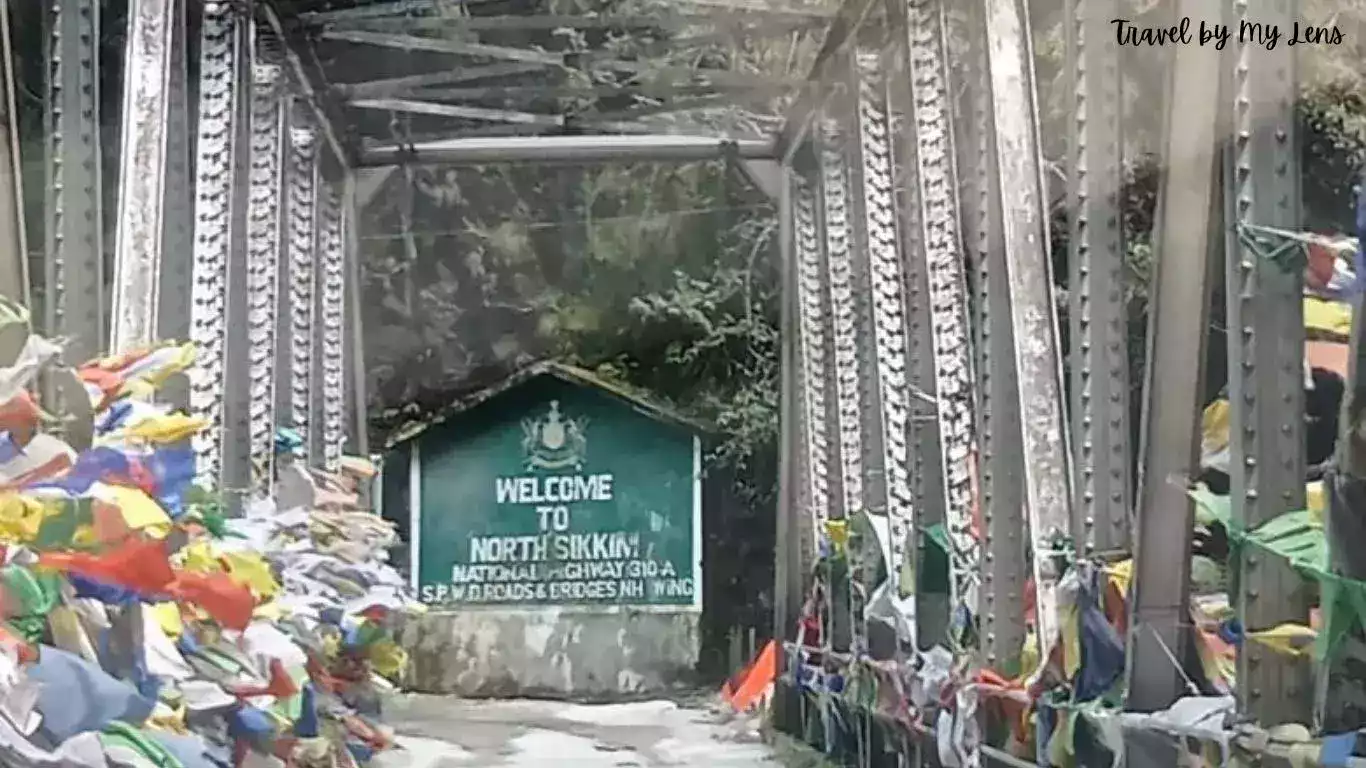
After crossing the Ratey Chu bridge, we continued our journey for about 7 kilometres, going through the picturesque towns of Kabi and Phensang.
We shortly arrived at our first stop, the “Seven Sisters Waterfall”. A handful of travellers were already present here, delighting in the splendour of this place.
The waterfall gets its name from its seven cascading stages, although only three of them are visible from ground level. As the water gushes down, it creates a mesmerizing sight. To add to the beauty, there was a small Buddha portrait nearby, providing a serene ambiance.
At the stop point, we found paid public toilets and small eateries run by locals, offering a variety of snacks and refreshments. We spent around 20 minutes at the Seven Sisters Waterfall, capturing photographs and admiring its beauty.
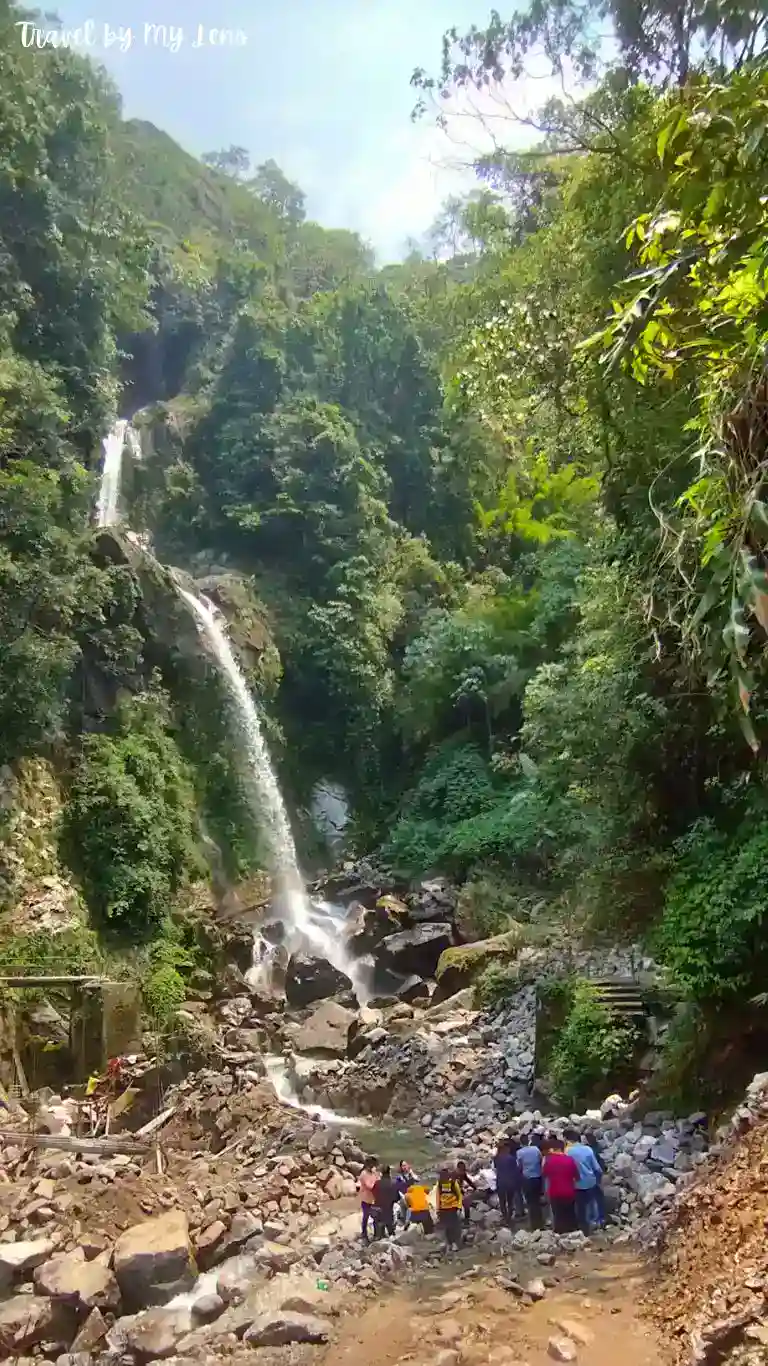
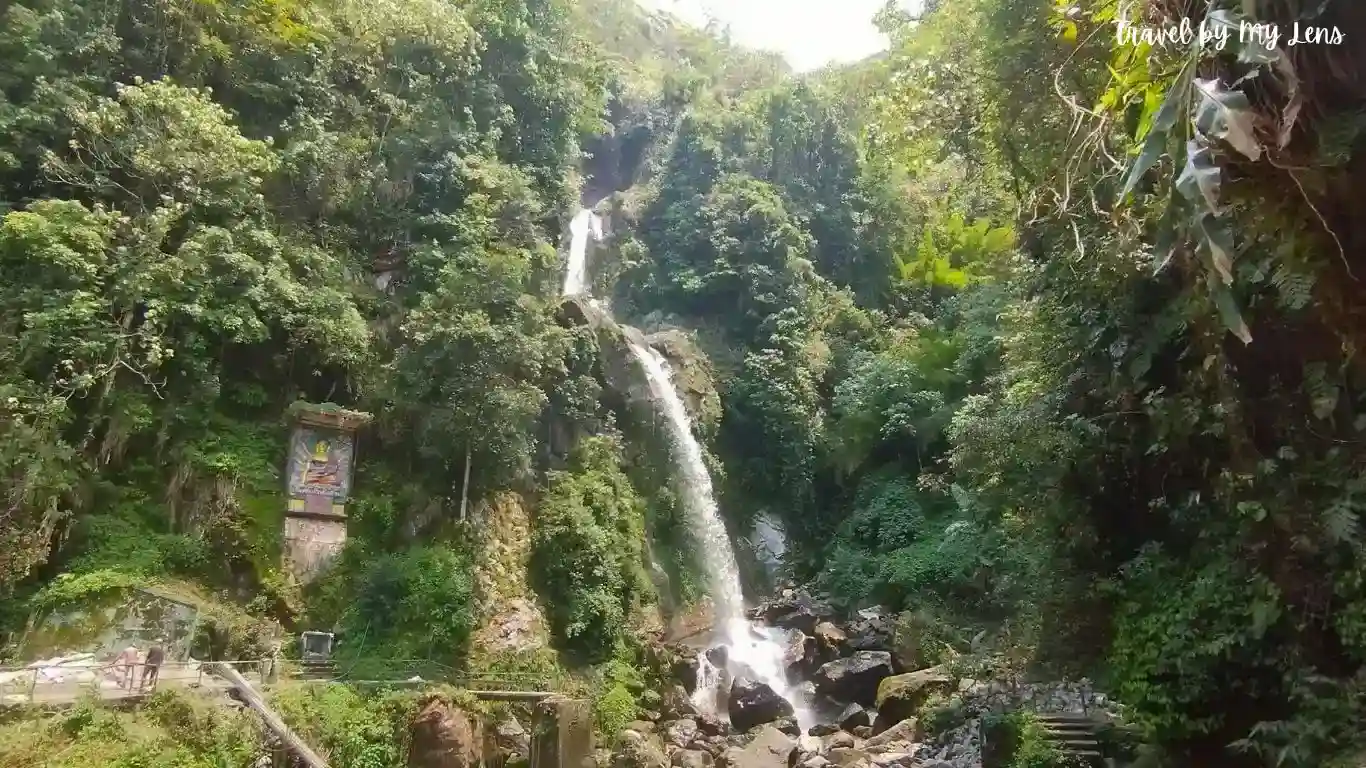
Next on the way, passing through the picturesque Phodong village, we arrived at the Namok View Point, approximately 50 kilometres from Gangtok.
At the Namok View Point, we couldn’t resist taking a quick photo stop to soak in the breathtaking vistas of the lush green valleys.
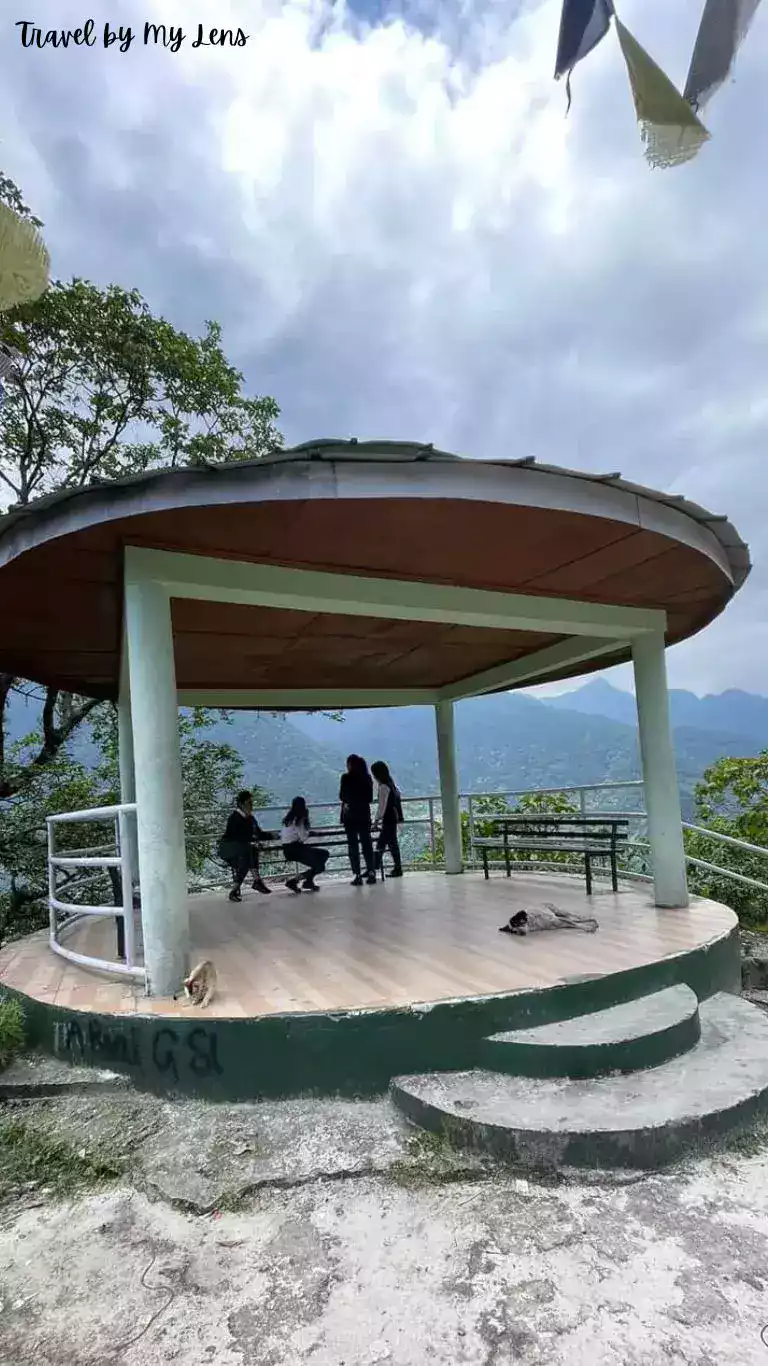
As we continued our journey, we soon arrived at the charming township of Mangan, which serves as the district headquarters of North Sikkim and is situated approximately 65 kilometres from Gangtok.
Mangan is a common stopover for many tourist vehicles, offering a convenient place to have lunch and rest.
By this time, it was already around 11:30 AM, but since we had enjoyed a hearty breakfast earlier, we decided to skip lunch and continue with our adventure.
For those in need of refuelling, Mangan is the last available fuel station on this route, so it’s advisable to fill up your vehicle’s tank here before proceeding further.
Additionally, at Mangan, there is a checkpoint where your permit will be verified. With our permits in order and our spirits high, we were ready to resume our journey, eager to discover more of the enchanting landscapes and experiences that awaited us on the road to Lachung.
About 4 kilometres ahead of Mangan, we reached the charming village of Singhik and couldn’t resist making another quick photo stop at the roadside viewpoint.
This spot is renowned for providing the best views of the majestic Kanchenjunga peak, especially when the weather is clear.
Not only did the viewpoint offer views of the Kanchenjunga but we were also treated to the mesmerizing sight of the Teesta River flowing gracefully through the lush valley below. Our journey was turning out to be a treasure trove of picturesque sights.
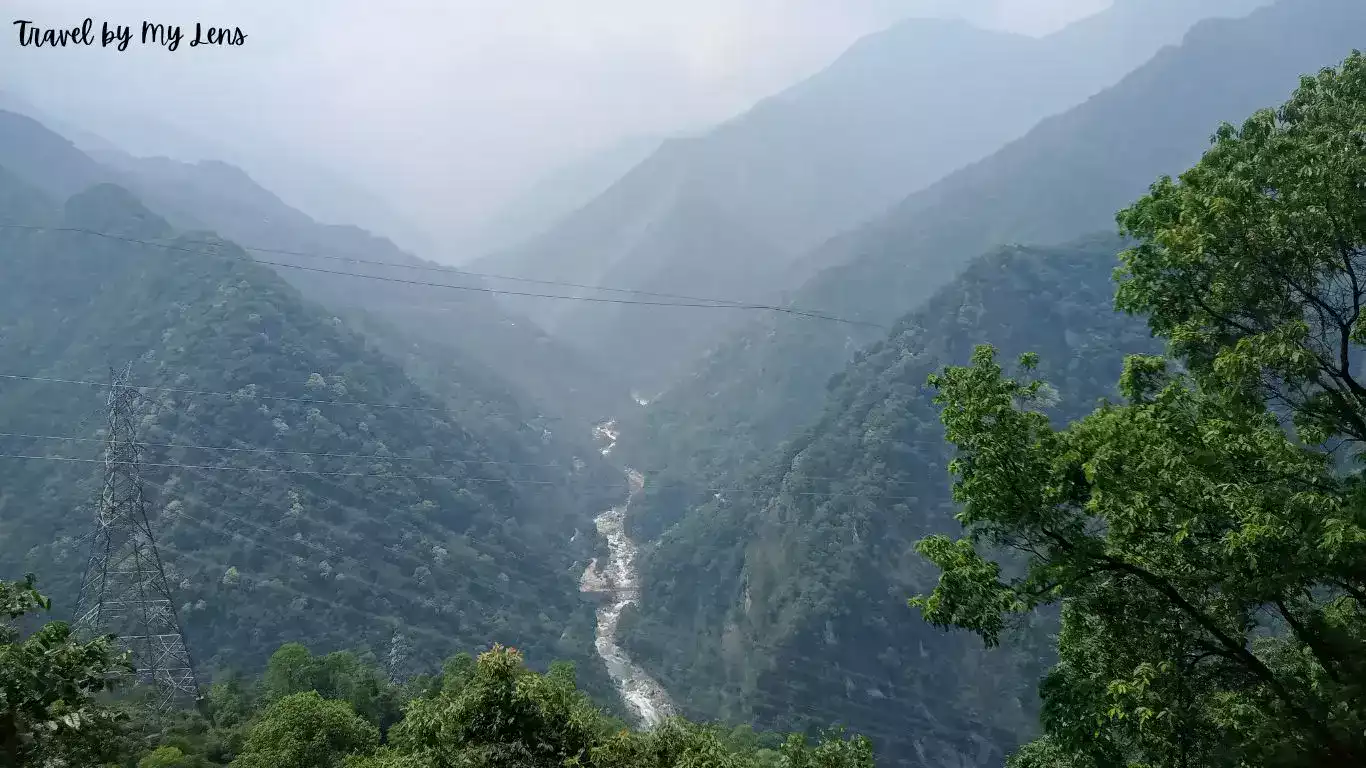
One of the most spectacular and well-known waterfalls in North Sikkim is the Naga Falls, located approximately 17 kilometres ahead of Mangan. This captivating waterfall descends in multiple tiers from a great height, and its source remains hidden from view.
Since we had begun our journey early and minimized our stops along the way, we were fortunate to arrive at Naga Falls with hardly any crowds around.
This allowed us to fully immerse ourselves in the serene beauty of the place and enjoy the tranquil atmosphere. As we were preparing to leave, we noticed that a number of vehicles had already lined up at the site.
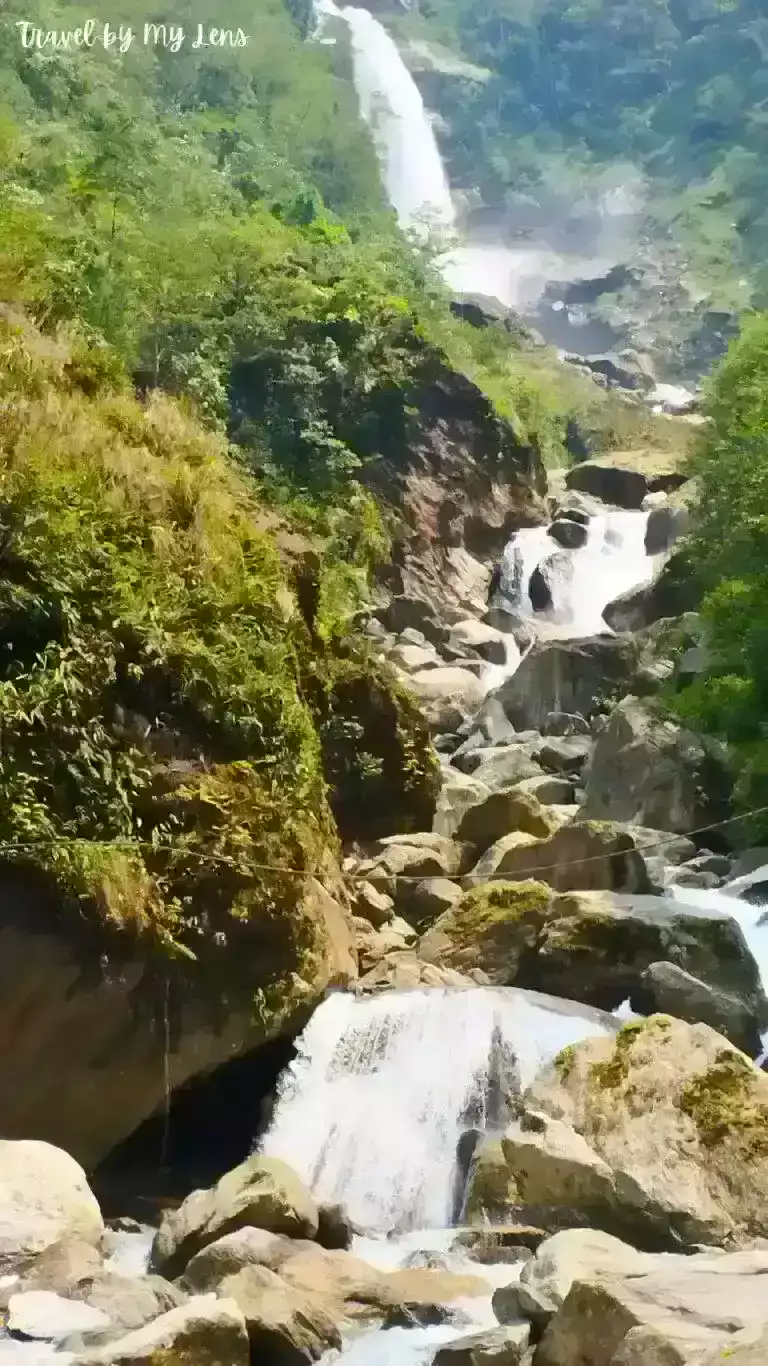
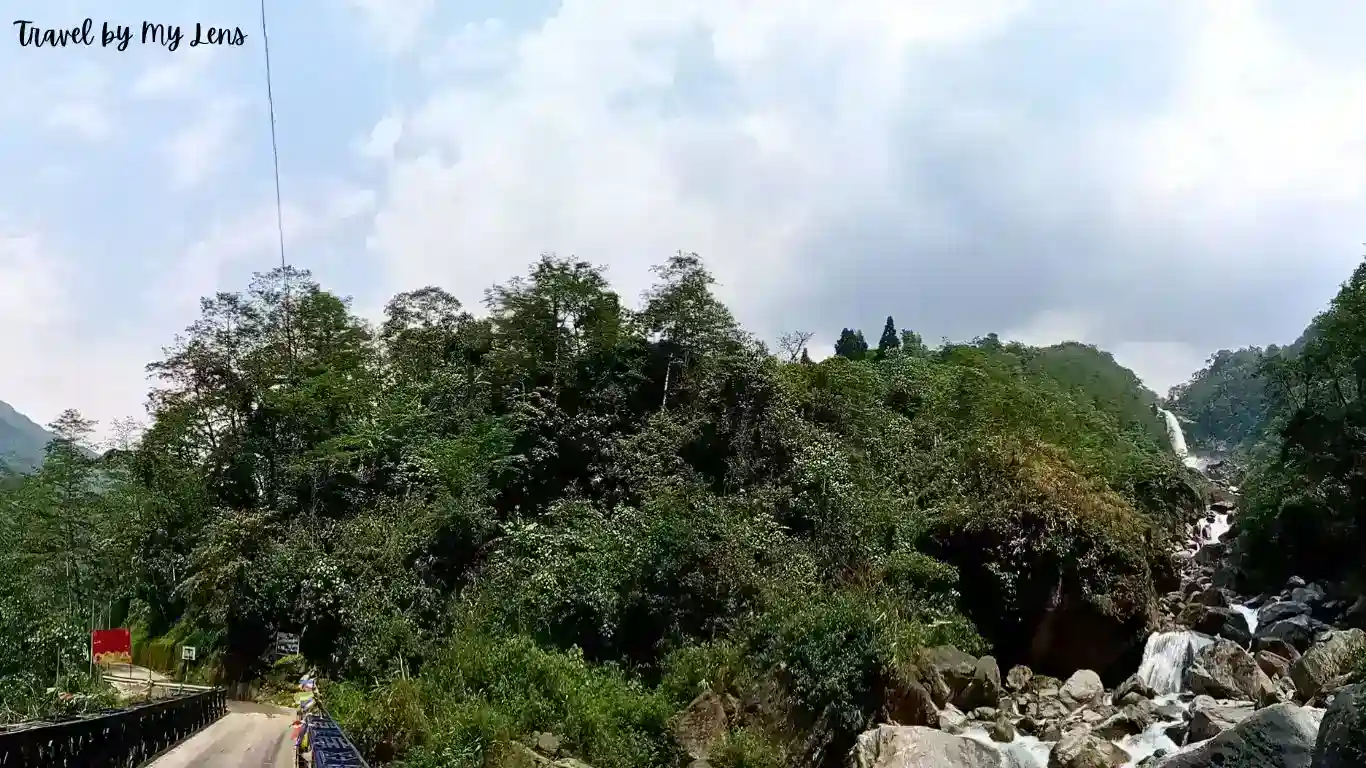
Continuing our journey, we arrived at the second checkpoint on this route, known as the Toong Police Checkpost, situated around 3 kilometres from the Naga Waterfall.
Here, the authorities verify the Inner Line Permit (ILP) to ensure that visitors have the required permissions to proceed further into North Sikkim.
Beyond this point, carrying plastic water bottles is not allowed. If you happen to carry any plastic water bottles, you will need to dispose of them at this checkpoint. North Sikkim has taken a strong stance against plastic usage to protect its pristine environment.
As a result of the plastic ban, you won’t find any Bisleri or other plastic water bottles available beyond this checkpoint. Instead, it’s a good idea to carry reusable water bottles or opt for other eco-friendly alternatives to stay hydrated during the rest of the journey.
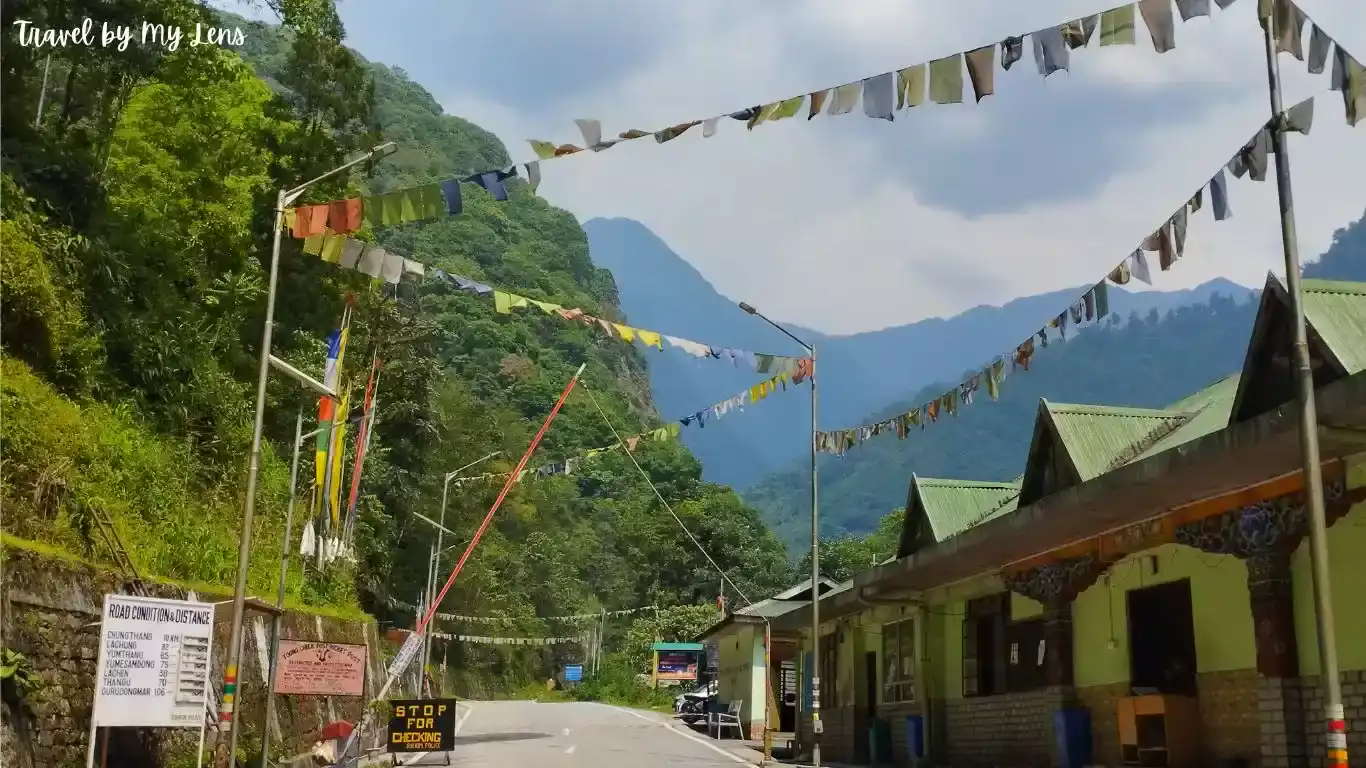
After crossing the Toong Police Checkpost and continuing our journey, the magnificent Teesta River began flowing on our left side all the way to Chumthang.
Our next destination was the picturesque township of Chumthang, which held its own charm and beauty.
Chumthang is a serene and lovely place where two streams, Lachung Chu and Lachen Chu, converge to meet the majestic Teesta River. (In the local language, “Chu” refers to a river.) The meeting point of these rivers created a captivating sight, and it was a perfect spot to pause and appreciate the forces of nature.
Adding to the significance of this location, a hydroelectric project had been set up at the confluence of these rivers, harnessing the power of the flowing waters to generate electricity.
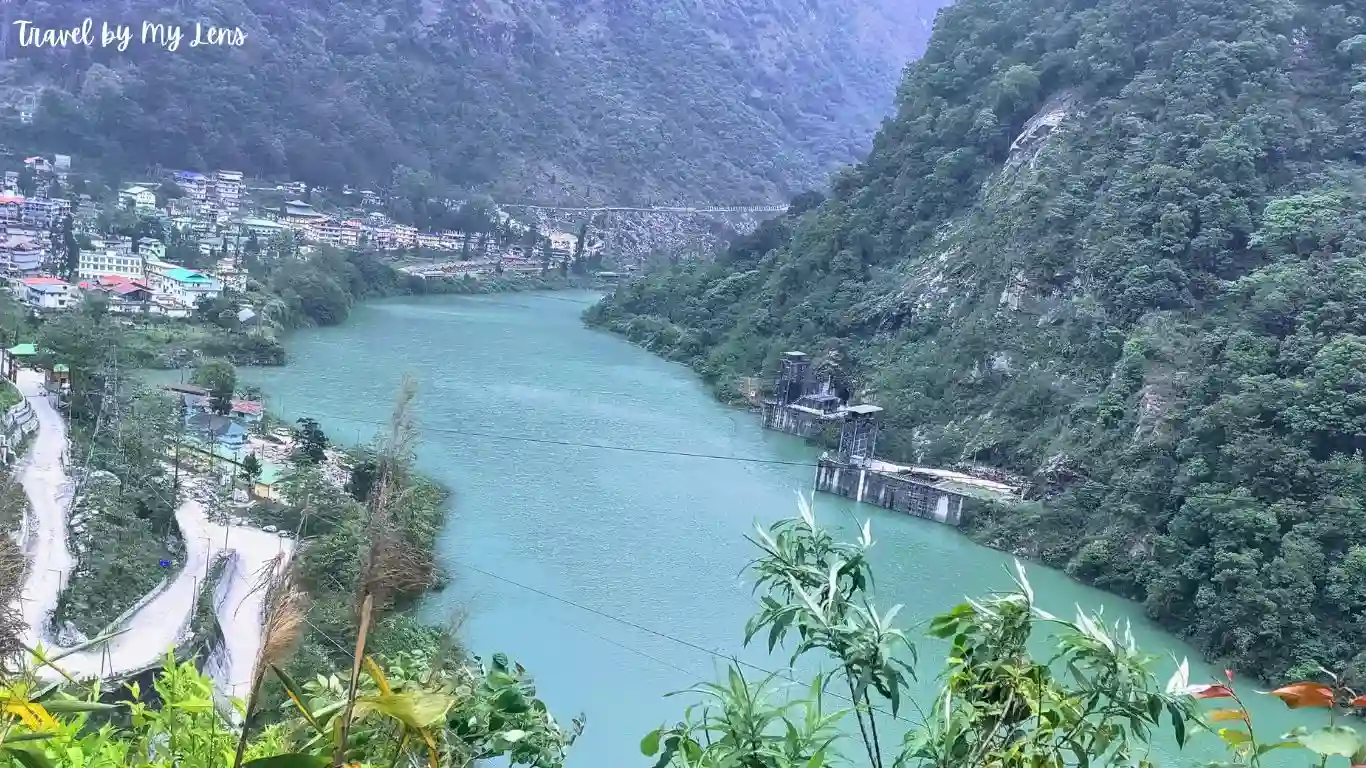
After leaving Chumthang, we encountered a Y junction with two roads diverging, one leading towards Lachen and the other towards Lachung. We took the road that led us to Lachung, our next destination.
Approximately 10 kilometres from Chumthang, we reached our last stop point before reaching Lachung, the Bhim Nala Waterfall, affectionately known as the Amitabh Bachchan Waterfall.
The waterfall gained its name due to a scene from the movie “Ankhen,” which starred Amitabh Bachchan and was reportedly shot at this very location.
The villagers have constructed a small wooden platform using bamboo and logs, providing an elevated viewpoint to better enjoy the scenic beauty of the waterfall. They charge a nominal fee of 10 rupees per person for using this platform.
Alternatively, the waterfall is also visible from the roadside, and visitors can catch a glimpse of its splendour without using the platform. Additionally, there are paid toilets available at this stop point, ensuring that visitors have convenient facilities during their visit.
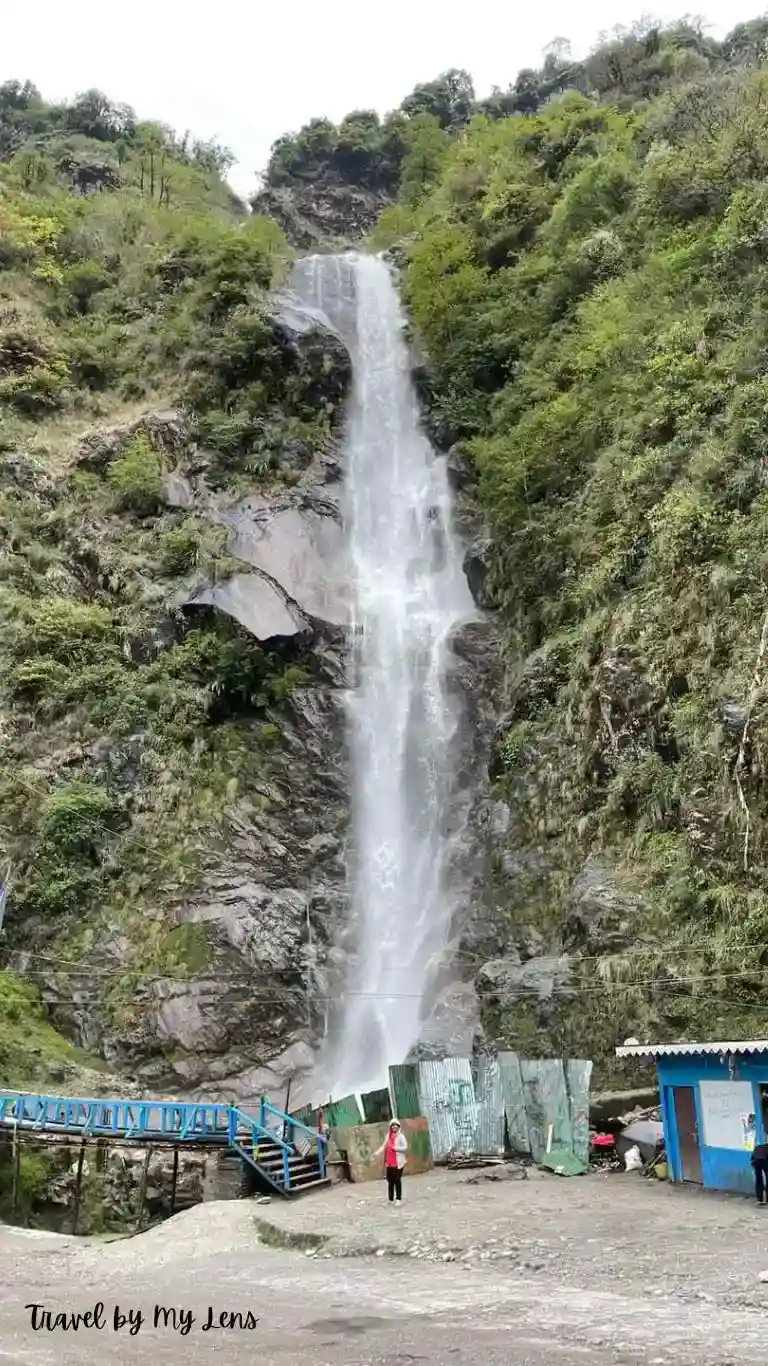

Around 1 PM, feeling a bit hungry, we decided to grab a quick bite and ordered some comforting Maggi noodles from a roadside shop. The shop had a catchy and memorable name: “Hum Hai Raahi Pyar Ke, Phir Milenge Chalte Chalte.”
As we savoured our Maggi, we noticed an adjoining shop where a talented local artist named Raghu was singing some delightful Bollywood karaoke songs. His soulful renditions added to the ambiance and created a pleasant atmosphere around the area.
We struck up a chat with Raghu since we were impressed by his talent. He shared that, besides performing in the shop, he also took part in local concerts.
We were delighted to have the chance to interact with such a talented individual and were amazed by the hidden talents that the journey to Lachung had brought us in contact with.
Having enjoyed Raghu’s melodious songs and wishing him luck in his musical pursuits, we resumed our journey towards Lachung. The road from this point onward was narrow and winding, with numerous twists and turns and a significant elevation change.
The journey was becoming more than just a physical exploration; it was an immersive experience that touched our senses and ignited our spirits.
Around 3 p.m., we finally arrived at our hotel in Lachung, the Le Coxy resort, after an amazing but slightly tiring journey. The driver informed us that he would be ready to pick us up at 7 a.m. the next day.
The weather was quite chilly, so we quickly settled down in our room to warm up. Despite the tiredness, we were excited about being in Lachung.
Since we had some time on our hands, We decided to take a leisurely stroll through the village, interacting with the locals and learning about their way of life. The village was charming, surrounded by stunning mountain vistas.
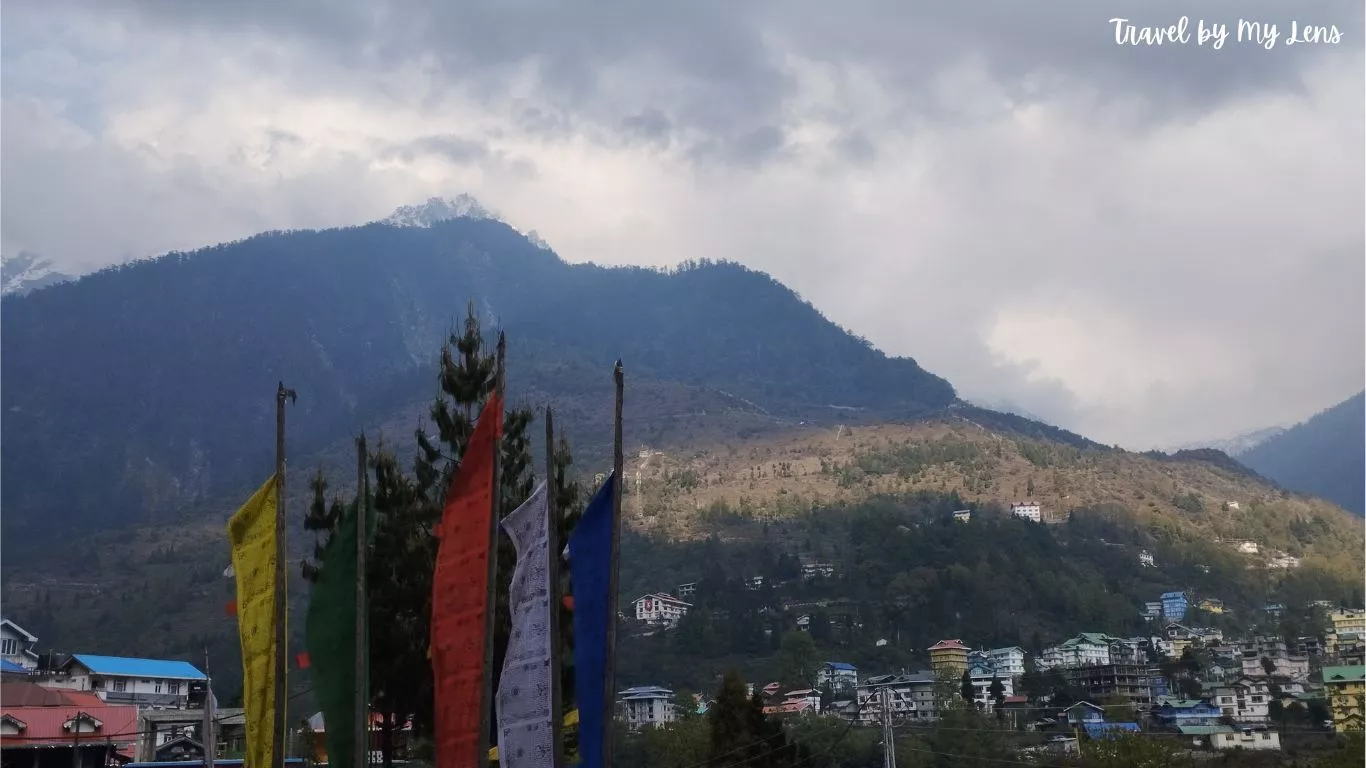
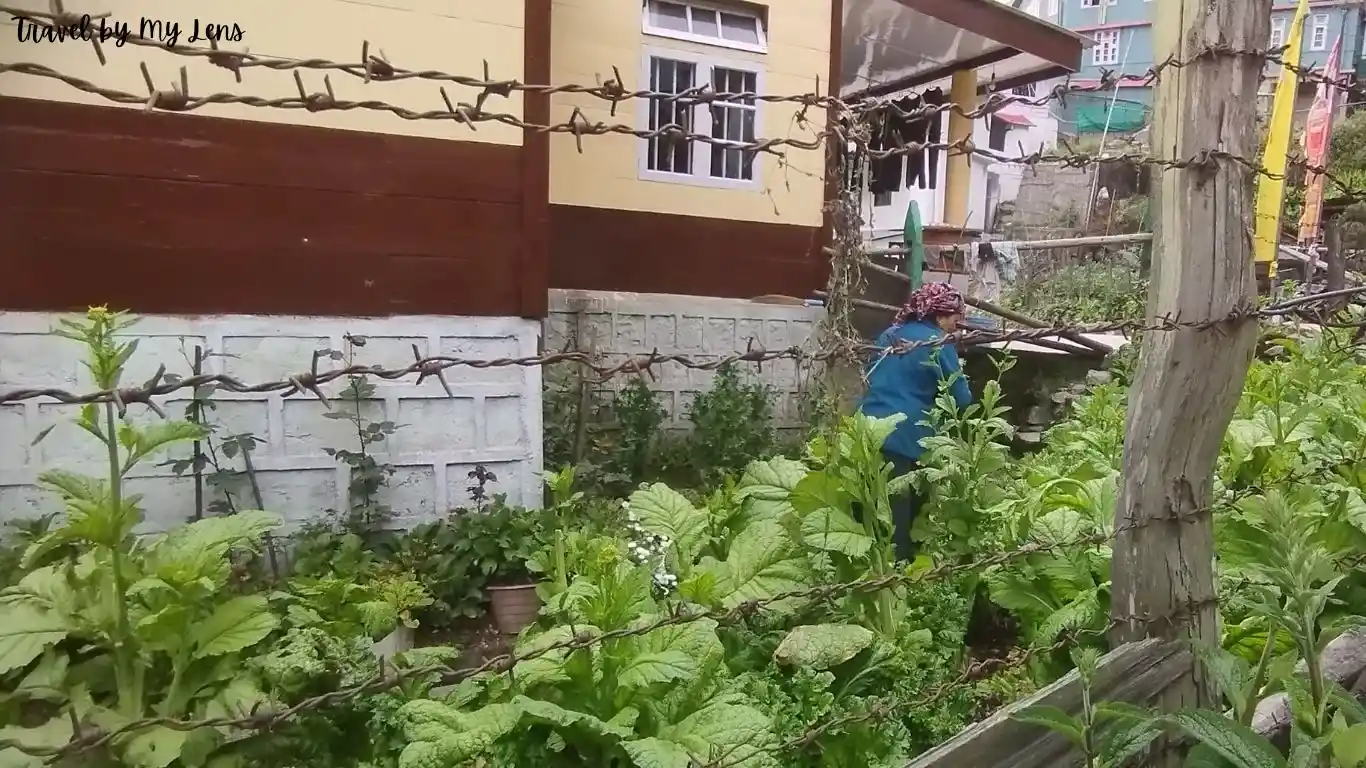
As we strolled through the streets of the village, we came across the Lachung River, and just beyond the bridge, we found a quaint sit-out area. The spot was perfect for taking in the serene beauty of the river and the surrounding mountains.
We decided to pause for a while and enjoy the tranquil atmosphere while listening to the soothing sound of the flowing water. It was a peaceful moment amidst the breathtaking scenery of Lachung.
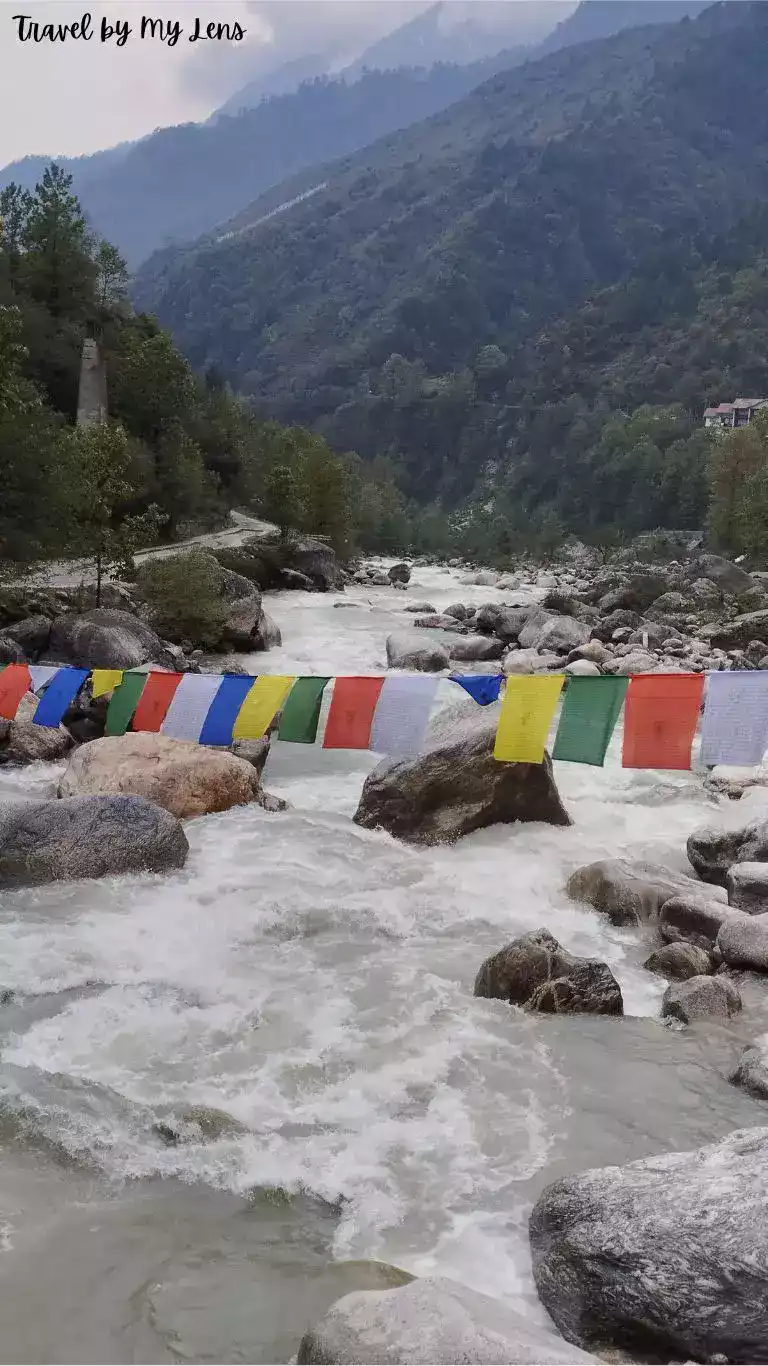
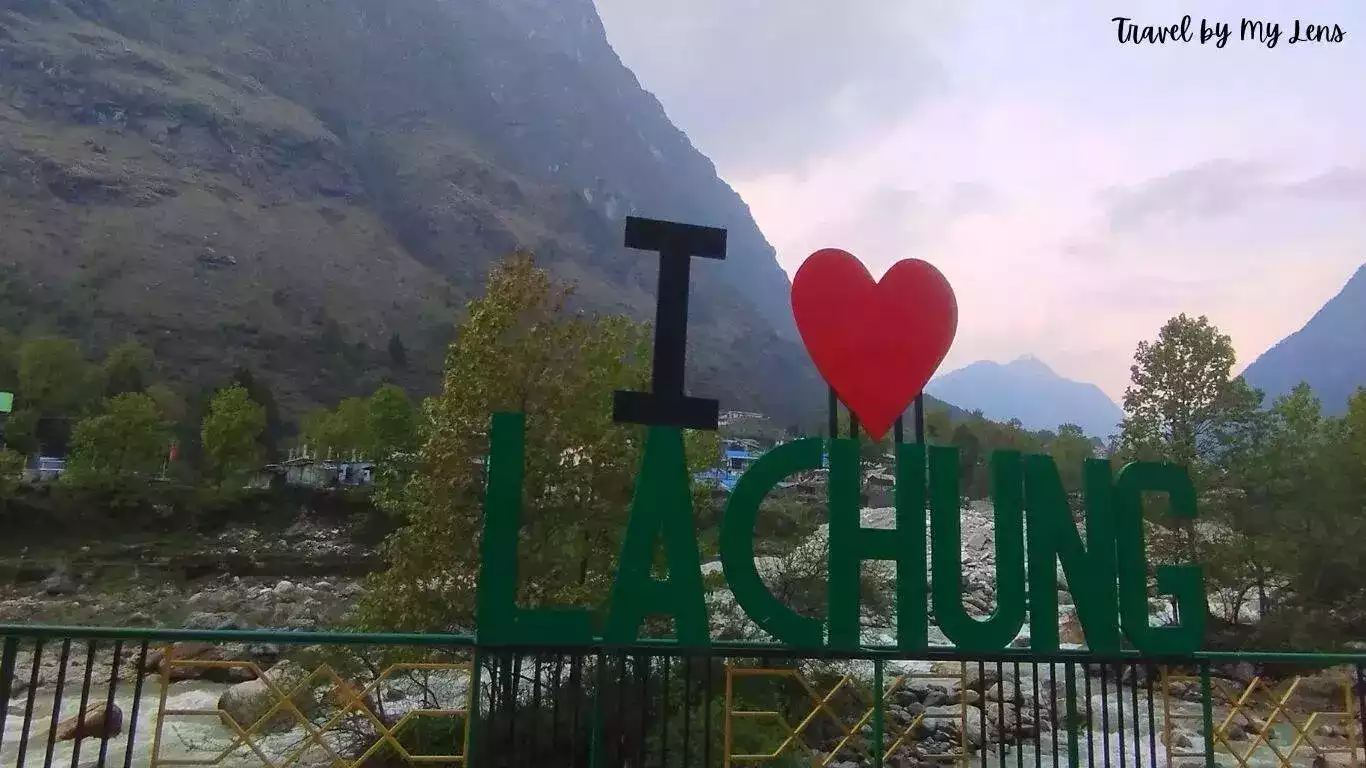
After our leisurely stroll, we returned to the hotel at around 5 p.m. and took some time to unwind and relax in our room. The journey had been eventful, and we needed to recharge our energy.
We arrived at the hotel’s dining area at about 7:30 p.m. The hotel’s packages included meals, which was convenient since there weren’t many eating places nearby. The food at the hotel was delicious and satisfying.
For those who want to explore the local cuisine, it’s worth checking with the locals to see if they can recommend any local food items or if someone can prepare local delicacies for you.
Trying out local dishes can be a delightful way to experience the flavours and culinary traditions of Lachung.
After enjoying a delicious dinner at the hotel, we had a chance to interact with some fellow travellers who were also staying there. It was wonderful sharing travel stories and experiences with like-minded individuals.
As the night grew late, we decided to call it a day and returned to our room to get some much-needed rest.
We knew that another exciting day awaited us, and we wanted to be well-rested and ready to embrace whatever adventures Lachung had in store for us.
With the anticipation of more incredible experiences, we drifted off to sleep, eager for the new day to unfold.
DAY 02: Lachung - Yumthang Valley - Zero Point - Gangtok
Good Morning, Lachung! As we woke up to embrace the new day, we were filled with gratitude towards the hotel staff for their thoughtful gesture of providing bed warmers without any extra charge for the night.
The chilly weather could have been a challenge during the night, but the bed warmers made our sleep peaceful and comfortable.
The hotel had thoughtfully arranged an early morning breakfast for us, ensuring we could start our day with a hearty meal.
With our hunger satisfied and checkout formalities completed, we eagerly awaited the arrival of our driver. As the clock struck 7.30 AM, the driver arrived, ready to take us on our Lachung adventure.
With the driver at the helm, we set off on our expedition. Our plan for the first half of the day was to explore two of the most captivating attractions: Yumthang Valley and Zero Point.
Yumthang Valley, located at an altitude of about 11800 feet, is about 25 kilometres from Lachung and takes about an hour and 20 minutes to drive.
There is a checkpoint shortly after Lachung, and in peak season, it is advisable to start your journey early to avoid long queues at this checkpoint.
The drive to Yumthang is undeniably scenic and offers breathtaking views of the surrounding landscapes. Around 8.30 AM, we reached the enchanting Yumthang Valley.
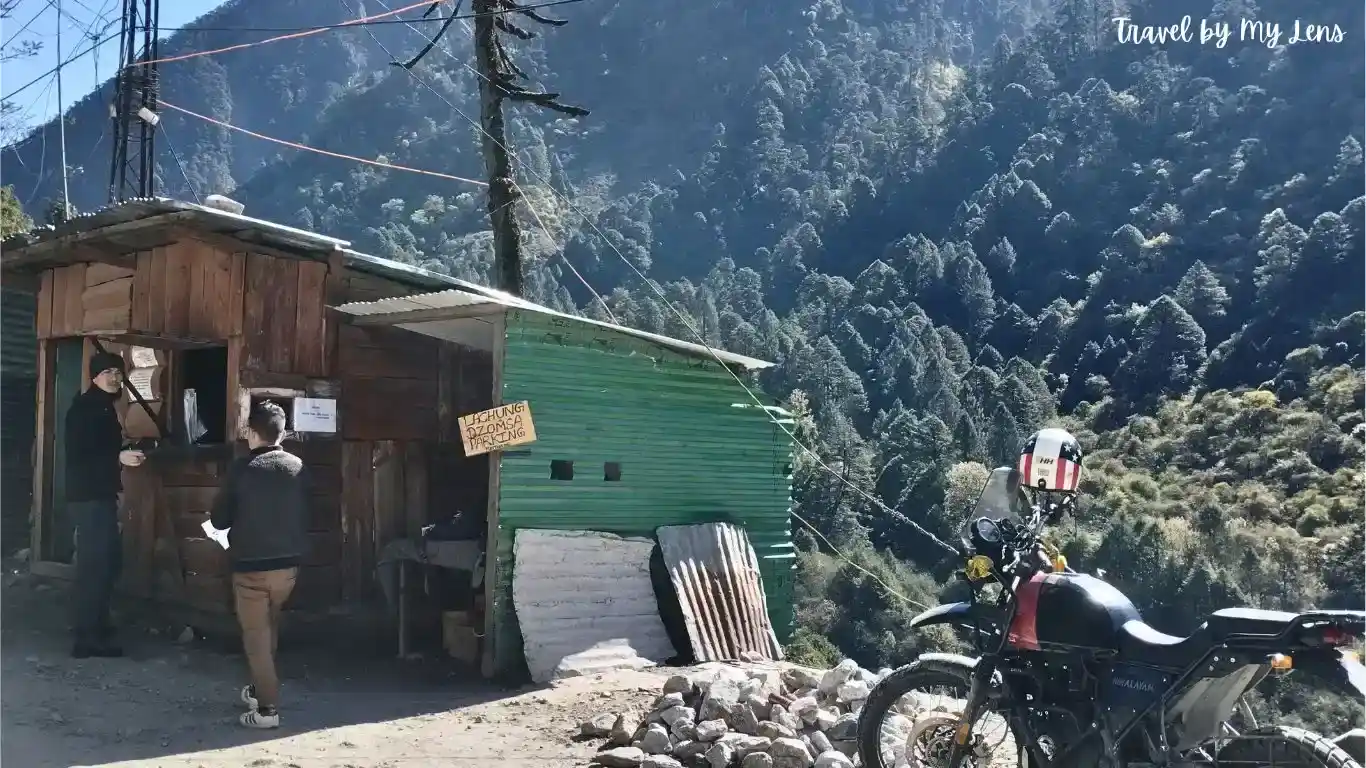

With Zero Point as a part of our itinerary, we made a brief stop for a biobreak at Yumthang Valley. Our driver informed us of the plan to visit Zero Point first and then return to Yumthang on the onward journey.
The distance between Yumthang and Zero Point is approximately 23 kilometres, and the drive typically takes around 1 to 1.5 hours, depending on road conditions and other factors.
After freshening up and rejuvenating ourselves, we resumed our adventure and set off towards Zero Point. The anticipation of reaching the highest accessible point in the region added to our excitement.
The drive to Zero Point was nothing short of an adventure, with scenic vistas unfolding at every turn. After a journey of approximately 2.30 hours, we finally arrived at Zero Point around 10 a.m.
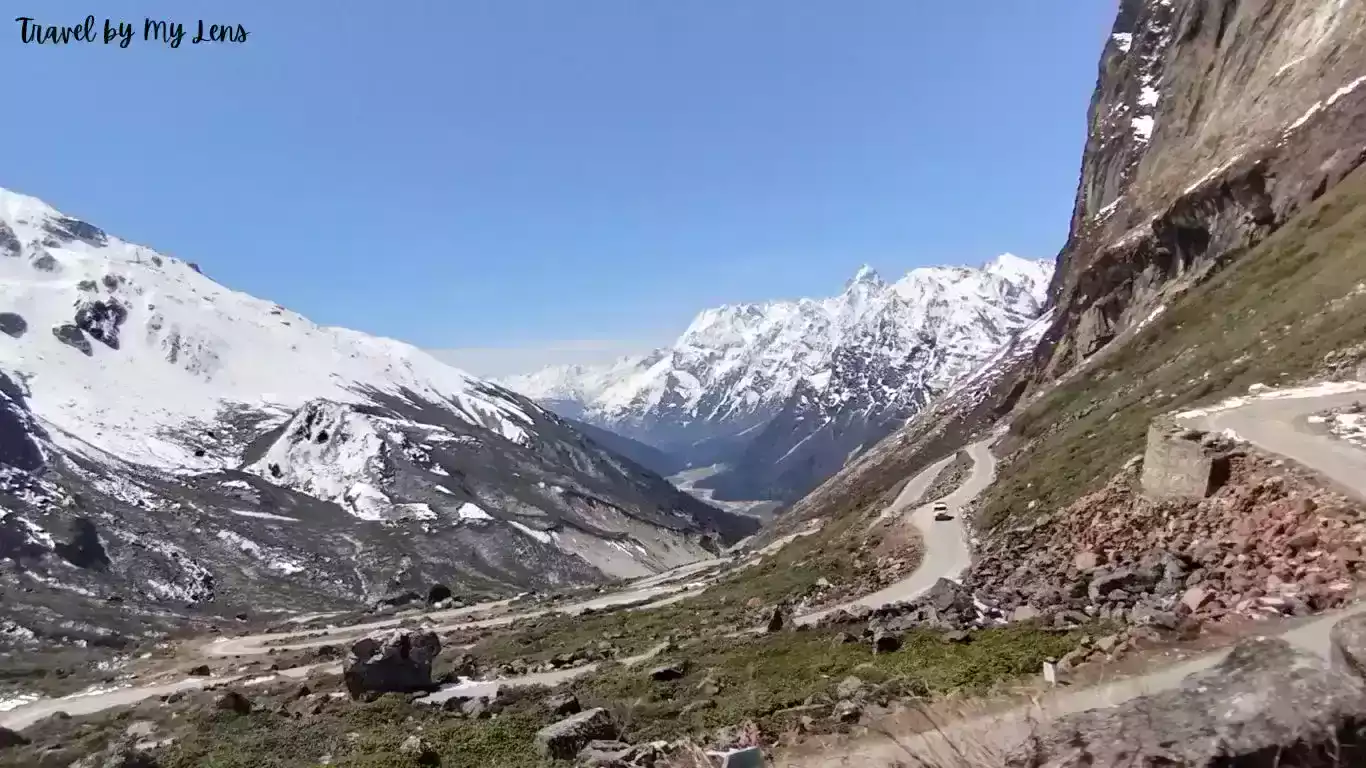
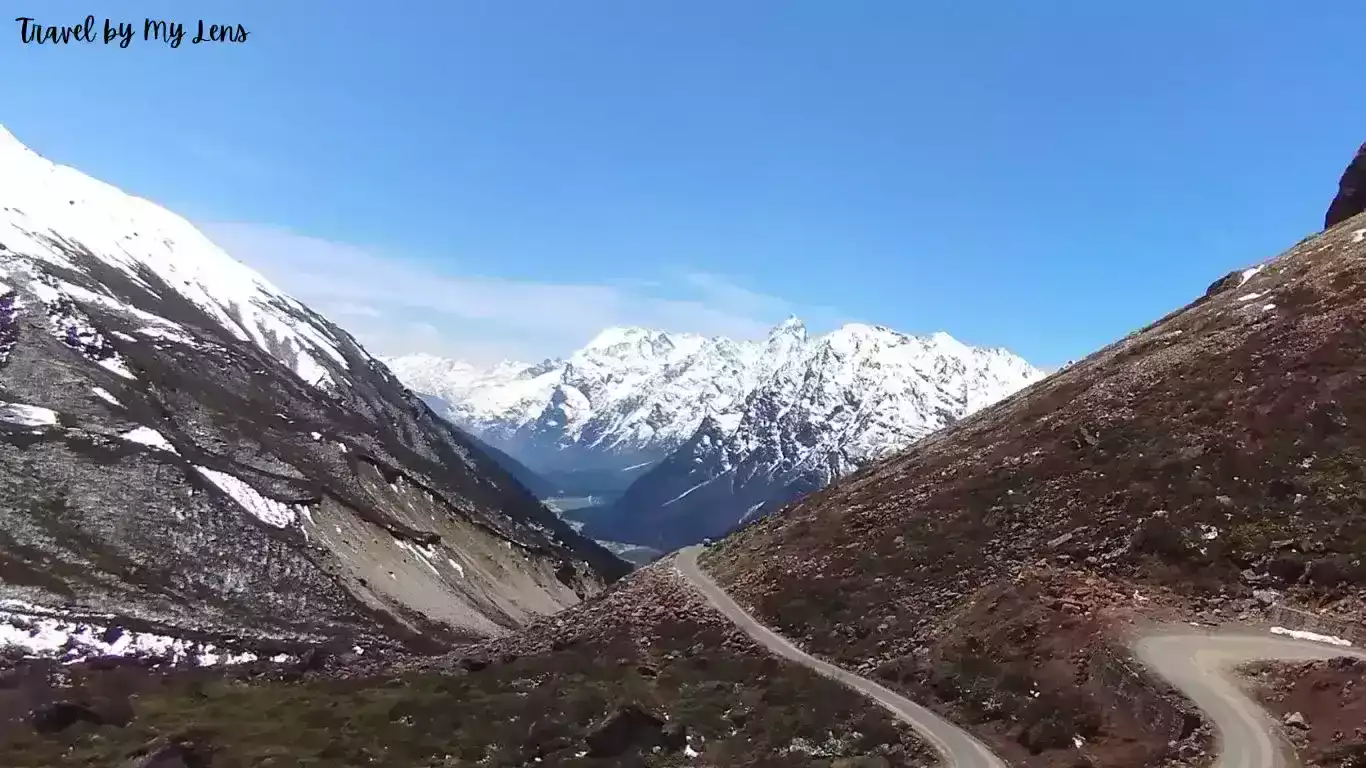
Zero Point, also known as Yumesamdong, is situated at an altitude of approximately 15,300 feet (4,700 metres).
The name “Zero Point” is derived from the fact that the civilian road ends about 7 kilometres from this location, specifically at Zadong, and beyond that point lies the border with China.
Due to its proximity to the international border, access to Zero Point is restricted, and foreigners are not permitted to visit this area.
Snow-capped mountains and pristine landscapes spread as far as the eye can see from Zero Point. Standing at Zero Point, one can truly feel the majesty of the Himalayas and appreciate the raw beauty of the high-altitude region.
Renting snow boots from a nearby shop for Rs. 100 per pair, we relished the snowy landscape for approximately 30 minutes. However, given the high altitude, it is not recommended to linger here for an extended period.
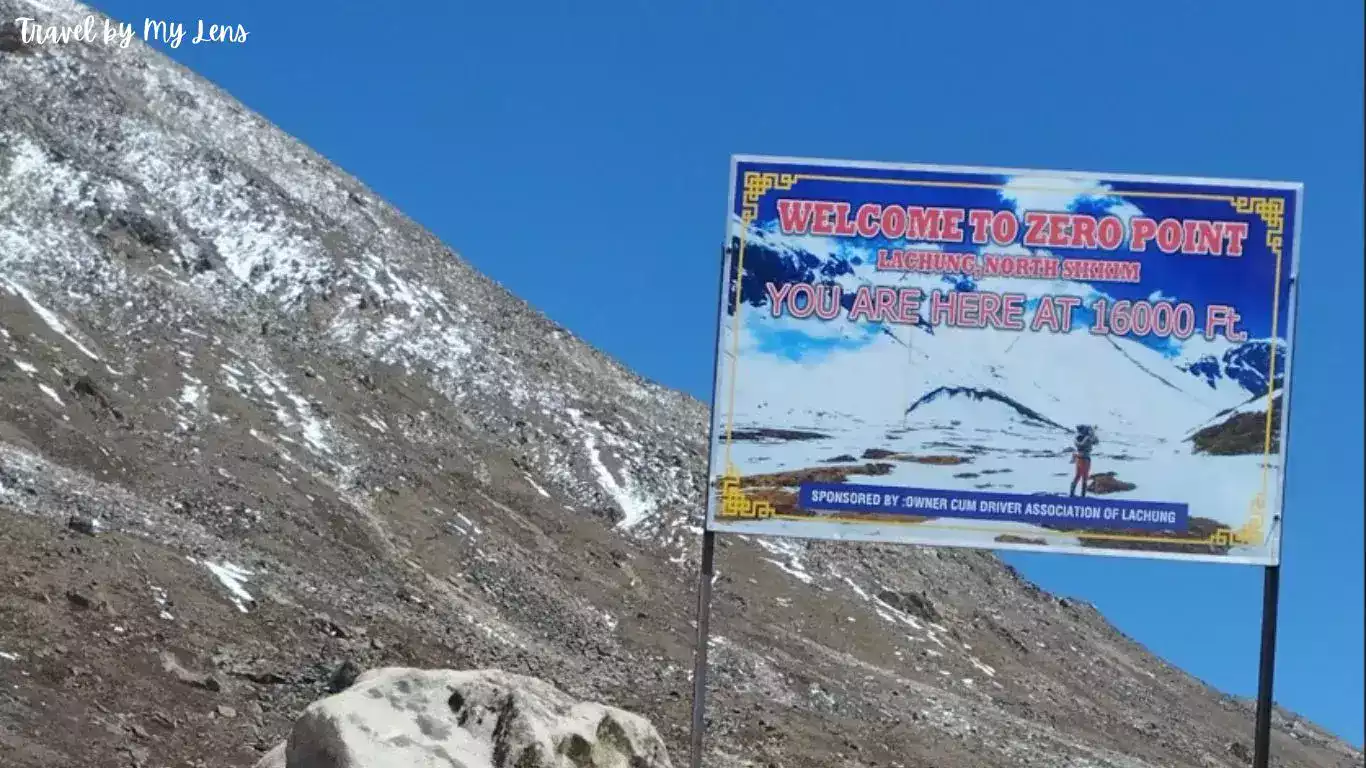
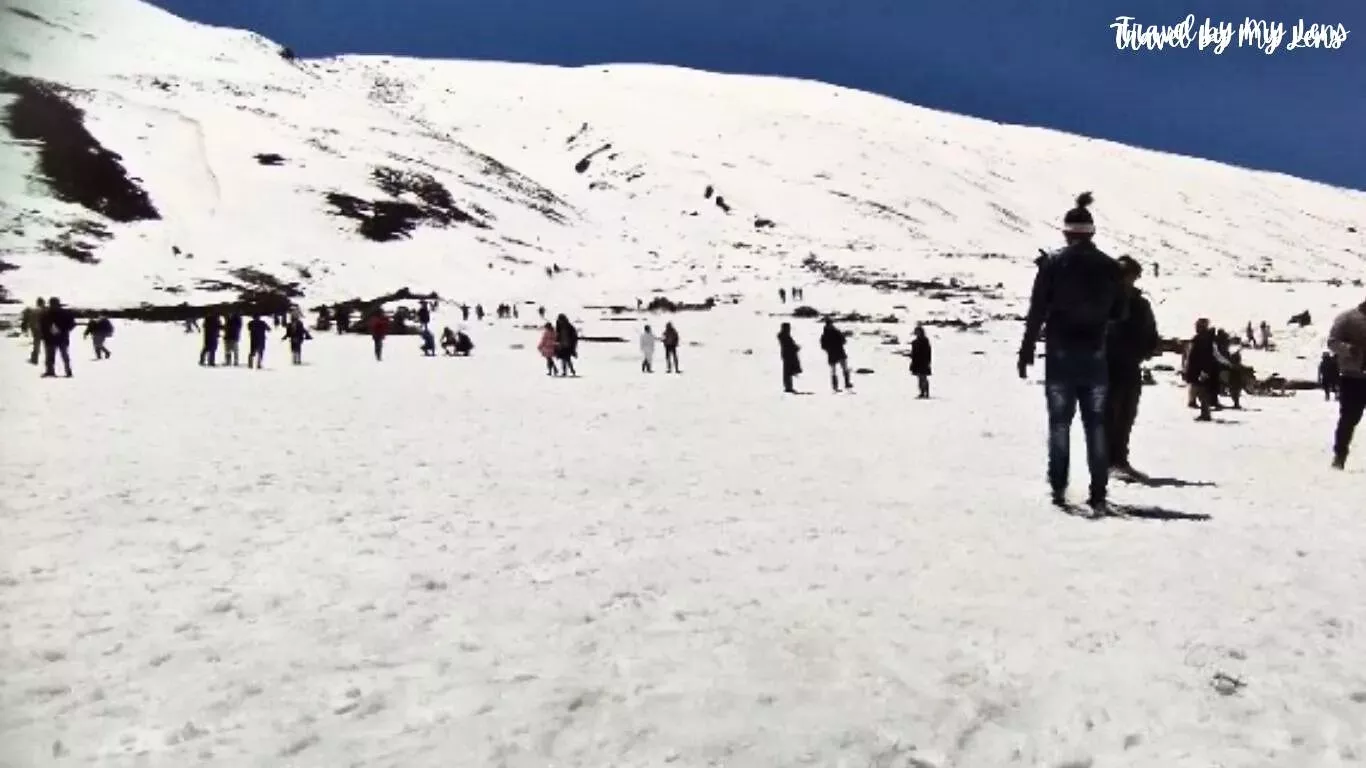
Embarking on our return journey, we made our way back to Yumthang Valley, and by approximately 11:30, we once again reached this picturesque destination.
Yumthang Valley, also known as the Valley of Flowers, is a captivating destination renowned for its vibrant alpine flowers, hot springs, and the Shingba Rhododendron Sanctuary.
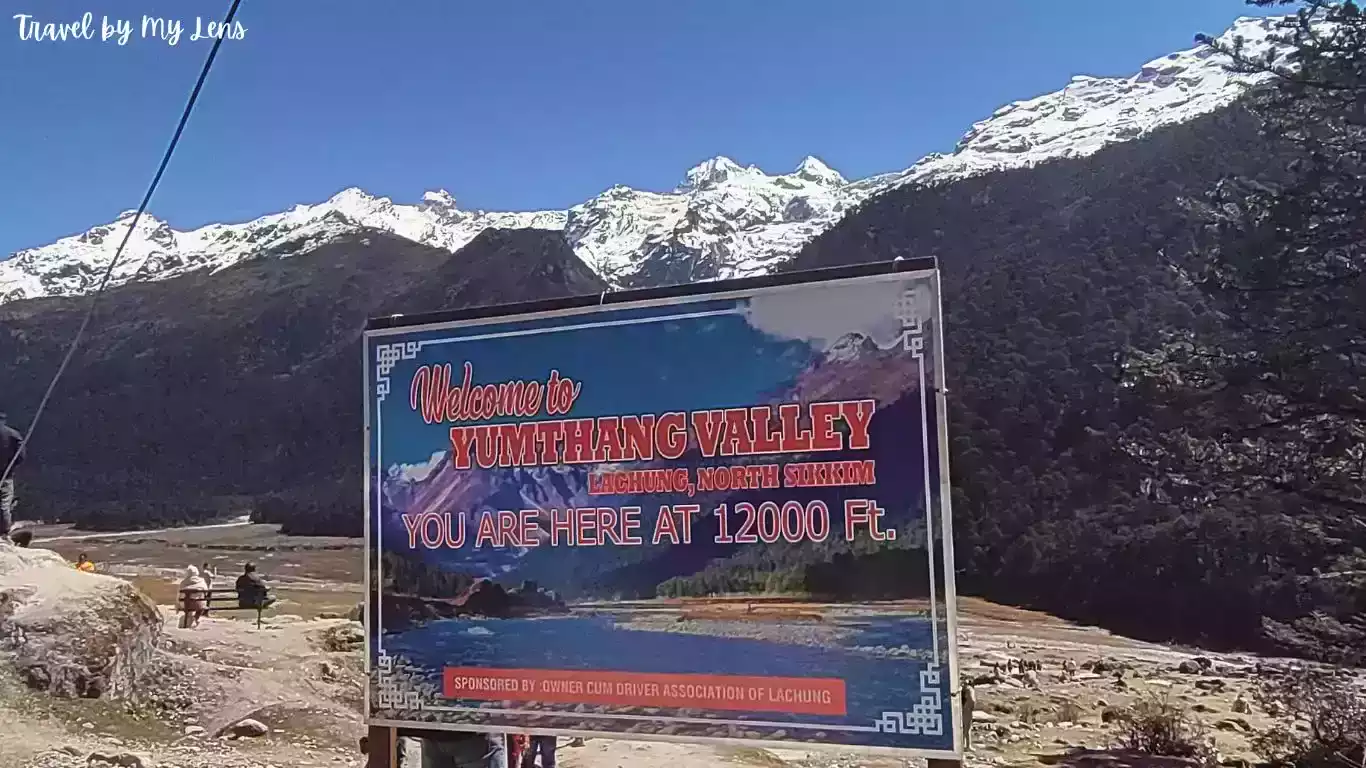
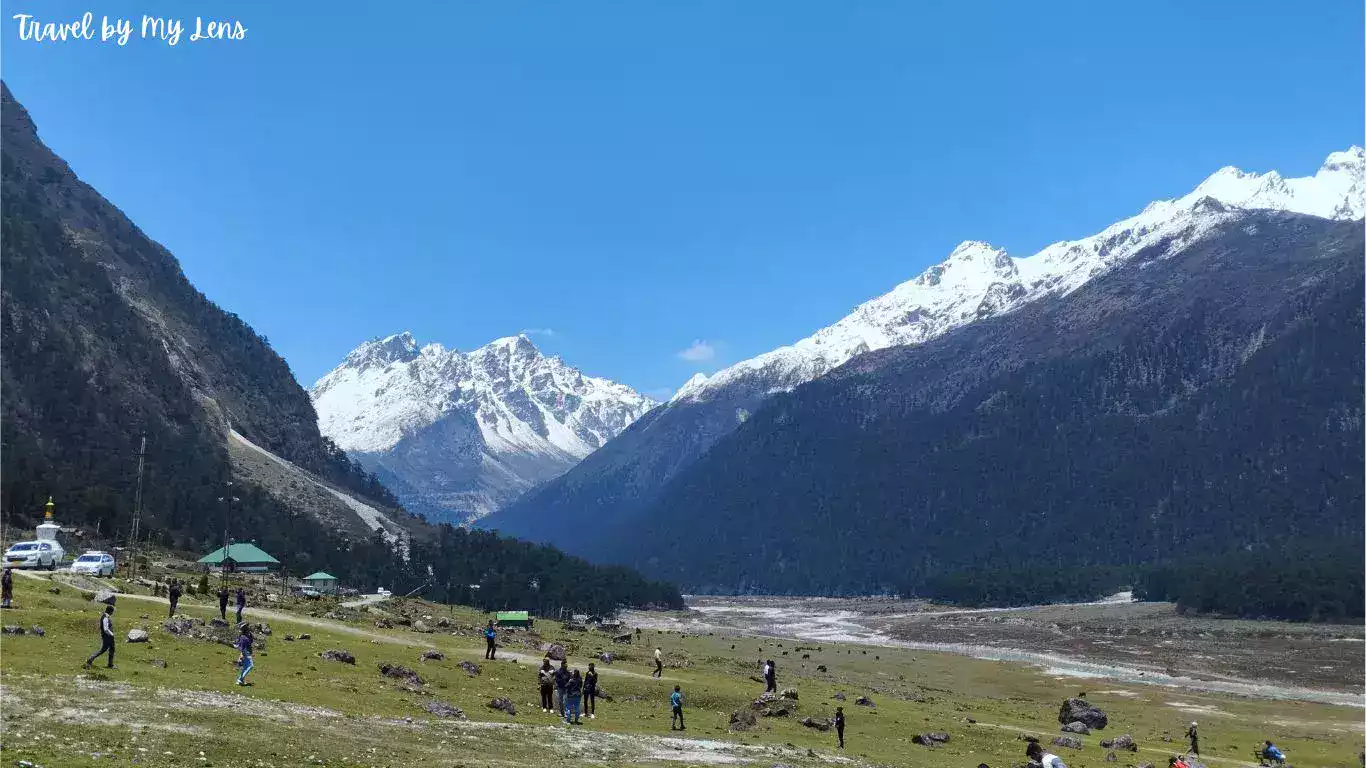
The valley comes alive with a riot of colours during the months of April and May, when various flowers bloom in full splendour. As soon as we stepped out of the car, we were welcomed by a postcard-worthy scene.
The breathtaking landscape stretched before us, with snow-clad peaks soaring majestically in the distance. The glistening Yumthang River meandered through the valley, adding a touch of serenity to the picturesque setting.
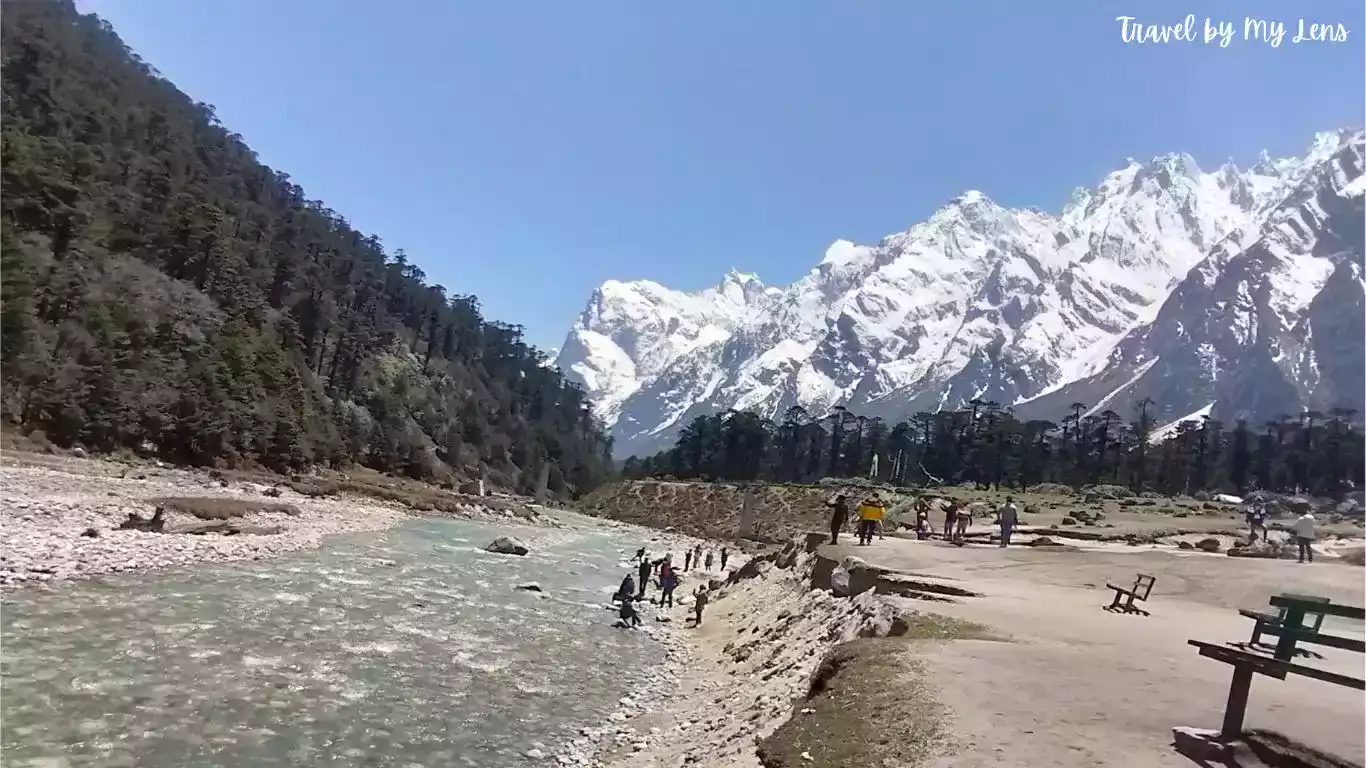
Staying in Yumthang Valley for about an hour, we immersed ourselves in the sheer beauty of the surroundings, creating cherished memories that would last a lifetime.
Before embarking on the onward journey, we made it a point to indulge in a mandatory treat: piping hot Maggi from the roadside shop.
As we reluctantly bid farewell to Yumthang Valley, we carried with us the joy and wonder of the moments spent in this heavenly abode.
Around 1 PM, we began our return journey to Gangtok. En route, we made a quick stop at Mangan to grab some food before continuing our journey towards Gangtok.
By 6.30 PM, we had returned to the city of Gangtok, marking the end of our eventful day.
As per our plans, we made a quick stop at the captivating Bakthang Waterfall. Taking a moment to appreciate the natural beauty, we captured a few final photographs to preserve the memories of our incredible journey.

Finally, the driver dropped us off at our next hotel in Gangtok, the Udaan Woodberry Hotel. After a day filled with incredible experiences and adventures, we were looking forward to relaxing and unwinding in the comfort of our new accommodations.
North Sikkim had left an indelible mark on our hearts, and we vowed to return someday to explore more of its hidden treasures.
With a bag full of memories and a sense of gratitude for this remarkable journey, we bid adieu to this enchanting land, promising to cherish the experiences forever. The journey had come to an end, but the magic of the mountains would remain etched in our hearts forever.
How to Reach Lachung
Lachung is only accessible by road from the capital city of Gangtok. To get to North Sikkim (Lachung or Lachen), you must travel by road through Gangtok.
Lachung is 110 kilometres from Gangtok, and the total travel time is about 5–6 hours, including stopovers and road conditions. You’ll pass through small towns like Mangan, Singhik, and Chungthang along the journey.
There is a diversion from Chumthang to Lachung on one side and Lachen on the other. Both are around 30 kilometres from this point.
If you wish to avoid Gangtok and only travel to Lachung, you may choose Mangan as your base location and take a road trip to North Sikkim from there.
Best Time to Visit Lachung
The Best time to visit Lachung is from March to mid-June (Spring) and mid-September to mid-December (Autumn). Avoid the monsoon and Winter months, as there could be potential road closures due to landslides or snowfall.
Permits and Travel Regulations to Visit Lachung
Similar to visiting Nathula, you might need to obtain special permits, Inner Line Permit (ILP), for visiting Yumthang Valley and Zero Point. These permits can be arranged through the concerned authorities or with the help of tour operators in Gangtok.
Suggested Tour Plan for North Sikkim
1 Night / 2 Days Tour
Day 1: Gangtok to Lachung and overnight stay at Lachung
Day 2: Early Morning to Yumthang Valley, Zero Point and return to Gangtok by evening
1 Night / 2 Days Tour
Day 1: Gangtok to Lachen and overnight stay at Lachen
Day 2: Early Morning to Gurudongmar Lake, Chopta Valley and return to Gangtok by evening
2 Night / 3 Days Tour
Day 1: Gangtok to Lachen and overnight stay at Lachen
Day 2: Early Morning to Gurudongmar Lake, Chopta Valley. Reach Lachung by evening and overnight stay at Lachung
Day 3: Early Morning to Yumthang Valley, Zero Point and return to Gangtok by evening
Where to Stay in Lachung
Le Coxy Resort
Magellan’s The Golden Bridge
Yashshree Lachung
For an authentic Lachung experience, you may also consider staying with local families and indulging in their traditional delicacies.
Traveller Tips for Travelling in Lachung
1. It is essential to bring appropriate medication to prevent high altitude sickness during your trip. For elderly individuals, considering a portable oxygen cylinder in the vehicle can be beneficial. Additionally, carrying camphor can help manage oxygen-related concerns.
2. North Sikkim experiences extreme weather conditions, so pack warm clothes, especially during the winter months.
3. It’s advisable to hire a local driver or take a guided tour for your journey to North Sikkim, as the terrain can be challenging and they are familiar with the local conditions.
4. Plastic bottles (Bisleri and all) are banned in North Sikkim.